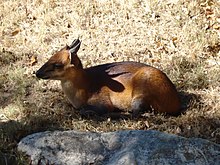Red-flanked duiker
| Red-flanked duiker | |
|---|---|
 |
|
| Red-flanked duiker, Cephalophus rufilatus | |
| Scientific classification | |
| Kingdom: | Animalia |
| Phylum: | Chordata |
| Class: | Mammalia |
| Order: | Artiodactyla |
| Family: | Bovidae |
| Genus: | Cephalophus |
| Species: | C. rufilatus |
| Binomial name | |
|
Cephalophus rufilatus Gray, 1846 |
|
The red-flanked duiker (Cephalophus rufilatus) is a species of small antelope found in western and central Africa in countries as far apart as Senegal and Sudan. Red-flanked duikers grow to almost 15 in (35 cm) in height and weigh up to 31 lb (14 kg). They have russet coats, with greyish-black legs and backs, and white underbellies. They feed on leaves, fallen fruits, seeds and flowers, and sometimes twigs and shoots. The adults are territorial, living in savannah and lightly wooded habitats, and the females usually produce a single offspring each year. They have lifespans of ten to fifteen years in captivity.
The red-flanked duiker is one of the smallest species of antelope, growing to a height of about 34 to 37 centimetres (13 to 15 in) with a weight of around 12 to 14 kilograms (26 to 31 lb). The head and body are blackish-grey near the spine gradually blending into a reddish-brown colour on the neck and flanks. There are small white markings on the ears and snout and a dark streak runs along the centre of the face. A tuft of black hairs grows between the horns and further coarse dark hairs grow along the top of the neck. The legs are bluish-grey. The sexes are in general similar in appearance but males have short backward-pointing horns up to 9 centimetres (3.5 in) long. Females are often hornless, or may have shorter horns. Both males and females have large preorbital glands on their snout in front of their eyes which form bulges in their cheeks. These are common to all members of the genus Cephalophus but they are larger in the red-flanked duiker than in other species.
The red-flanked duiker is native to West and Central Africa where its range extends from Senegal and the Gambia in the west to Sudan and the Nile Valley in the east. Its main habitat is open savannah woodlands and the margins of forests but it also occurs in river basins with elephant grass (Pennisetum purpureum) or thick shrubby vegetation such as caperbushes (Capparis spp.) and tree acanthus (Acanthus arboreus).
Red-flanked duikers are territorial and mainly solitary, with a single antelope or a pair occupying a small territory for a few months and then moving elsewhere. The territory is marked with secretions from their preorbital glands. The duikers are most active in the early morning and shortly before dusk. They move about while browsing and keep a sharp lookout for possible predators; if startled, they lower their heads and dive into the nearest dense area of vegetation. They are hunted by a number of predators including leopards (Panthera pardus), crowned eagles (Stephanoaetus coronatus) and African rock pythons (Python sebae) but are also hunted by man, who probably kills more duikers than the other predators combined.
...
Wikipedia

